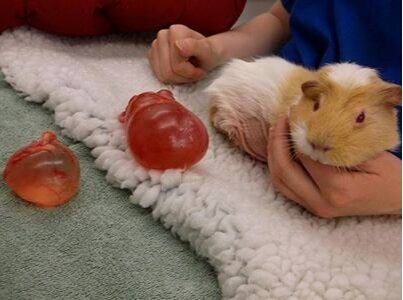When it comes to guinea pig sterilization, we all get the heeby-jeebies. But with advancement in the anaesthetic machines, drugs available and surgical techniques, you can feel more assured when you need to sterilize your sows now.
Up to 80% of all female piggies get womb issues. Ovarian problems like cysts and excessive production of hormones are at the top of this list! These malfunctioning ovaries tend to produce large amounts of hormones which also then cause the uterus to change and greatly increases the risk of uterine cancer.
With a simple technique of just removing the ovaries at an early age of 8months-1year, the risks of getting ovarian cysts, tumours, uterine cancers, breast tumours are reduced by over 60%!
The new technique involves 2 small incisions, about 1.5cm each on either side of the back to remove the ovaries in a quickie procedure under general anaesthesia. Piggies are usually up and eating within 1-2hours immediately after surgery. This recovery time (and costs) are similar to that of a dental procedure.
With ovarian cysts and uterine tumours, we normally have to perform a large 5-7cm incision, sometimes even 3 incisions to get all 3 portions out safely. This procedure takes a lot longer so the anaesthesia risks are higher and also has a longer recovery time. This is why we urge all sow owners to consider sterilizing early in life before health problems already occur.
Common clinical signs that you might see in a piggy with ovarian disease:
Large round belly but no chance of pregnancy
Weight loss, spine and hip bones can be felt easily
Fur loss along either/both sides of the belly
Crusting or swelling of the nipples
Change in urine colour- may have blood, brown discolouration
Pain when your piggy pees/poos, may squeak
Teeth grinding from pain
If you note any of the above symptoms, do speak to your vet as soon as possible. DO NOT ATTEMPT TO SQUEEZE THE BELLY, there have been cases where the cysts are so large, they can rupture.
Speak to a cavy savvy vet about sterilizing your piggy for a longer and better quality of life!
















